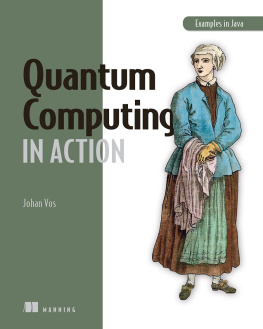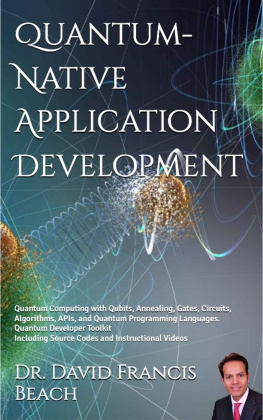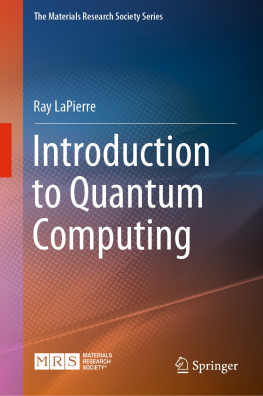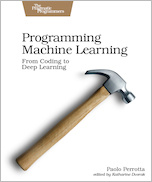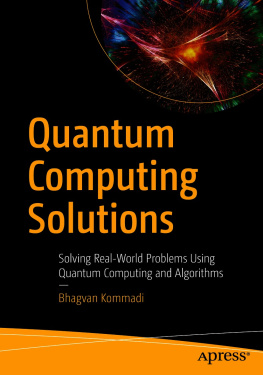Marto Torres - Quantum Computing
Here you can read online Marto Torres - Quantum Computing full text of the book (entire story) in english for free. Download pdf and epub, get meaning, cover and reviews about this ebook. year: 2021, publisher: UNKNOWN, genre: Computer. Description of the work, (preface) as well as reviews are available. Best literature library LitArk.com created for fans of good reading and offers a wide selection of genres:
Romance novel
Science fiction
Adventure
Detective
Science
History
Home and family
Prose
Art
Politics
Computer
Non-fiction
Religion
Business
Children
Humor
Choose a favorite category and find really read worthwhile books. Enjoy immersion in the world of imagination, feel the emotions of the characters or learn something new for yourself, make an fascinating discovery.

- Book:Quantum Computing
- Author:
- Publisher:UNKNOWN
- Genre:
- Year:2021
- Rating:4 / 5
- Favourites:Add to favourites
- Your mark:
- 80
- 1
- 2
- 3
- 4
- 5
Quantum Computing: summary, description and annotation
We offer to read an annotation, description, summary or preface (depends on what the author of the book "Quantum Computing" wrote himself). If you haven't found the necessary information about the book — write in the comments, we will try to find it.
Solving Real-World Problems Using
Quantum Computing and Algorithms
Quantum Computing — read online for free the complete book (whole text) full work
Below is the text of the book, divided by pages. System saving the place of the last page read, allows you to conveniently read the book "Quantum Computing" online for free, without having to search again every time where you left off. Put a bookmark, and you can go to the page where you finished reading at any time.
Font size:
Interval:
Bookmark:
Part I: Introduction 1
Introduction 3
Summary 20
Introduction 21
Initial Setup 21
Code Sample 29
Command for Execution 30
Output 30
Code Sample 32
Command for Execution 33
Output 33
Code Sample 34
Command for Execution 35
Output 35
Code Sample 42
Command for Execution 42
Output 43
Code Sample 44
Command for Execution 45
Output 45
Summary 46
Introduction 49
Initial Setup 50
Code Sample 51
Command for Execution 52
Output 52
Code Sample 58
Command for Execution 58
Output 58
Quantum Teleportation 59
Code Sample 62
Command for Execution 65
Output 66
Code Sample 67
Command for Execution 67
Output 68
Summary 68
Introduction 69
Initial Setup 69
Limitations of Quantum Computing 77
Summary 110
Introduction 111
Initial Setup 111
vii
Code Sample 115
Command for Execution 115
Output 115
Code Sample 117
Command for Execution 118
Output 118
Code Sample 120
Output 121
Summary 124
Introduction 125
Initial Setup 125
Code Sample 129
Command 130
Output 130
Code Sample 134
Command 135
Output 135
Summary 138
Introduction 141
Initial Setup 141
Code Sample 145
Command 147
Output 147
Code Sample 148
Command 149
Output 149
Command 153
Output 154
Summary 155
Introduction 157
Initial Setup 157
Code Sample 166 Command 169 Output 169 Summary 171
Introduction 173
Initial Setup 173
Code Sample 176
Command 177
Output 177
Code Sample 180
Command 183
Output 183
Code Sample 188
Command 188
Output 188
Summary 189
Introduction 191
Initial Setup 192
Code Sample 193
Command 194
Output 194
Code Sample 198
Command 200
Output 201
Code Sample 203
Command 208
Output 208
Code Sample 212
Command 219
Output 219
Summary 224
Introduction 225
Initial Setup 225
Summary 240
Introduction 241
Initial Setup 241
Code Sample 250
Command 256
Output 259
Summary 259
Code Sample 269
Command 269
Output 269
Code Sample 270
Command 272
Output 272
Summary 278
Index 295
Quantum computation is...a distinctively new way of harnessing nature.... It will be the first technology that allows useful tasks to be performed in collaboration between parallel universes.
David DeutschThis chapter gives an overview of quantum solutions. You will see how quantum computing can be applied in real life. The problem and solutions are presented with the solution benefits. The solution benefits are automation, cost reduction and profit improvements, efficiency improvement, and defect reduction.
The solutions covered in this chapter are related to cryptography, optimization, and cybersecurity.
Lets start by looking at the history of quantum computing and key achievements so far.
Richard Feynman proposed quantum electrodynamics in 1965 (see Figure 1-1 ). Quantum electrodynamics is related to the interaction of the electrons using the electromagnetic force of the photon. He invented the particles named antiparticles . Antiparticles are the particles that have charges opposite to the mirror particles.
He came up with new concepts related to quantum physical processes in 1980. He proposed that quantum states are represented by binary numbers.
David Deutsch came up with a concept called universal quantum computers in 1985. A universal quantum computer is based on the two-state system, which consists of a set of quantum gates.Quantum gates are a set of basic operations.
Peter Shor invented the quantum entanglementbased method for prime number factorization in 1994. This method is used to identify the prime factors of big numbers. The efficiency of the algorithm was much better compared to the previous methods. This research helped in creating research interest at other universities.
The trapped ion concept was first developed by the National Institute of Standards and Technology (NIST) and the California Institute of Technology in 1995. The concept is related to the ions that are trapped, and the temperature is decreased to a quantum state. In 1996 Bell Laboratories scientist Loy Grover developed Grovers algorithm, which is related to searching using quantum algorithms. A research team consisting of members from the University of California, Massachusetts Institute of Technology (MIT), Harvard University, and IBM invented a nuclear magnetic-resonance technology to modify quantum information in a liquid state.
David DiVincenzo proposed the basic characteristics for real quantum computer technology. Before David DiVincenzo, while Seth Lloyd was working in Los Alamos National Laboratory, he invented the molecular quantum computer. His proposal was based on a chain molecule structure. This structure has a pattern of little blocks, and it is repeating (see Figure 1-2 ).
This proposal was the basis for the first quantum computer concept. Seth Lloyds proposal was not created, but in 2000, David DiVincenzo created a list of criteria for quantum computer technology. The criteria are related to quantum computing and communication models.
A quantum computer consists of well-characterized quantum bits, and it is a scalable physical system.It needs to have the capability to create a set of quantum bits.
A quantum computer can set the initial state of the quantum bits. This is similar to a reset button on a desktop computer.
A quantum computer has long decoherence times.
Quantum computer has error correction related to the data retention in memory.
A quantum computer is based on a universal set of quantum gates. Quantum algorithms need to be executed on the computers. These algorithms might involve the rotation of quantum bits on a Bloch sphere and the entanglement of qubits.
It needs to have a measurement feature related to the state of quantum bits.
Information needs to be transferred along large distances. Quantum bits need to be transmitted between the source and destination.
The information needs to be retained in quantum bits after
transmission.
After DiVincenzo, Van Meter presented his thesis for building a quantum computer. The technology evolved from Van Meters thesis to a physical quantum computer. D-Wave came up with its own quantum computer. The latest update is that IBM is building a 53 quantum bit quantum computer. Google already has a 72 quantum bit quantum computer. The IBM Quantum computer will be accessible through its IBM Bluemix cloud environment.
Quantum solutions are related to building quantum algorithms for improving computational tasks within quantum computing, artificial intelligence, data science, and machine learning. Quantum solutions are picking up speed compared to quantum computer innovations. In this chapter, we look at various solutions such as optimization problems, quantum cryptography, and cybersecurity. This chapter explains the quantum solutions involving AI algorithms and applications in different areas. The other chapters of this book will present code samples. They will be based on real-life problems such as risk assessment and fraud detection in banking. In pharma, we look at drug discovery and protein folding solutions. Supply chain optimization and purchasing solutions are presented in the manufacturing domain. In the utility industry, energy distribution and optimization problems are explained in detail with solutions. Advertising scheduling and revenue optimization solutions are covered in the media and technology verticals.
Font size:
Interval:
Bookmark:
Similar books «Quantum Computing»
Look at similar books to Quantum Computing. We have selected literature similar in name and meaning in the hope of providing readers with more options to find new, interesting, not yet read works.
Discussion, reviews of the book Quantum Computing and just readers' own opinions. Leave your comments, write what you think about the work, its meaning or the main characters. Specify what exactly you liked and what you didn't like, and why you think so.



